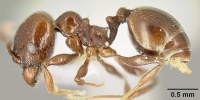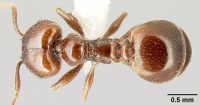Pheidole synanthropica
| Pheidole synanthropica | |
|---|---|

| |
| Scientific classification | |
| Kingdom: | Animalia |
| Phylum: | Arthropoda |
| Class: | Insecta |
| Order: | Hymenoptera |
| Family: | Formicidae |
| Subfamily: | Myrmicinae |
| Tribe: | Attini |
| Genus: | Pheidole |
| Species: | P. synanthropica |
| Binomial name | |
| Pheidole synanthropica Longino, 2009 | |
Pheidole synanthropica occurs in open, seasonally dry habitats. The type specimens were at a tuna bait in the "bosque humedo" of Santa Rosa National Park in Costa Rica, but all other collections have been from highly synanthropic habitats such as city parks, lawns, and coffee farms. (Longino 2009)
Identification
With the general habitus of Pheidole anima, Pheidole eidmanni, Pheidole maja, Pheidole piceonigra, and Pheidole plebecula. Minor worker: scape relatively short, SI 102-116, versus relatively longer, SI > 120 (anima, maja, piceonigra, plebecula); katepisternum foveolate, lacking irregular rugulae, versus with irregular rugulae overlaying foveolate sculpture (anima). Major worker: base of scape terete versus base of scape flattened (anima, maja, piceonigra); scape with no erect setae versus about 3 erect setae (plebecula); face with erect setae totally absent to very sparse versus with 10 or more erect setae (anima); anterior face with very reduced rugose sculpture versus with more extensive rugoreticulum (eidmanni, based on illustration of the major worker in Wilson [2003:289]); katepisternum sculpture as in minor worker; postpetiole in dorsal view robust, with strong triangular lateral conules, versus less transverse, with rounded, not conulate sides (anima); gaster with no erect setae versus with more than 5 erect setae (anima, plebecula).
Distribution
Costa Rica to Mexico (Chiapas)
Latitudinal Distribution Pattern
Latitudinal Range: 15.202° to 9.9°.
| North Temperate |
North Subtropical |
Tropical | South Subtropical |
South Temperate |
- Source: AntMaps
Distribution based on Regional Taxon Lists
Neotropical Region: Costa Rica (type locality), Honduras, Mexico, Nicaragua.
Distribution based on AntMaps
Distribution based on AntWeb specimens
Check data from AntWeb
Countries Occupied
| Number of countries occupied by this species based on AntWiki Regional Taxon Lists. In general, fewer countries occupied indicates a narrower range, while more countries indicates a more widespread species. |

|
Estimated Abundance
| Relative abundance based on number of AntMaps records per species (this species within the purple bar). Fewer records (to the left) indicates a less abundant/encountered species while more records (to the right) indicates more abundant/encountered species. |

|
Biology
It is remarkable that this species is not better known and just now being described. It is no doubt common throughout the highly urbanized central valley of Costa Rica, and, since it also occurs in coffee farms in the Sierra Madre de Chiapas in southern Mexico, probably occurs in similar areas throughout Central America. This is probably a case of the common ants in the back yard being ignored as eager collectors head for undisturbed forest. (Longino 2009)
Castes
Worker
Minor
Images from AntWeb
   
| |
| Paratype Pheidole synanthropica. Worker. Specimen code casent0609053. Photographer Stephanie Ware, uploaded by Field Museum. | Owned by FMNH. |
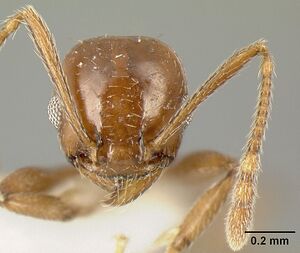   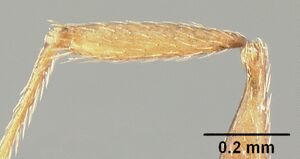 
| |
| Paratype Pheidole synanthropica. Worker. Specimen code casent0609038. Photographer John T. Longino, uploaded by California Academy of Sciences. | Owned by INBC. |
Major
Images from AntWeb
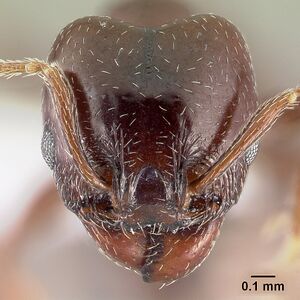   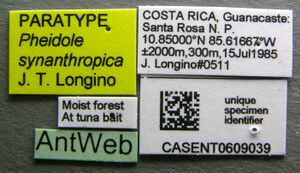
| |
| Paratype Pheidole synanthropica. Worker (major/soldier). Specimen code casent0609039. Photographer Erin Prado, uploaded by California Academy of Sciences. | Owned by CAS. |
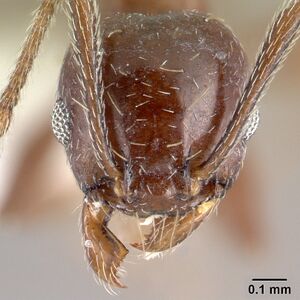  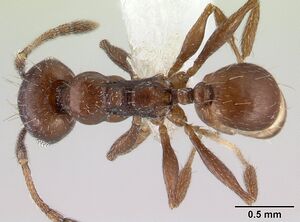 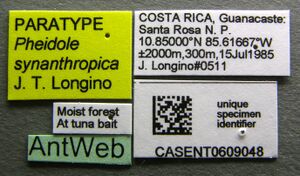
| |
| Paratype Pheidole synanthropica. Worker. Specimen code casent0609048. Photographer Erin Prado, uploaded by California Academy of Sciences. | Owned by CAS. |
 
| |
| Worker (major/soldier). Specimen code casent0609050. Photographer J. Longino, uploaded by University of Utah. | Owned by JTLC. |
Nomenclature
The following information is derived from Barry Bolton's Online Catalogue of the Ants of the World.
- synanthropica. Pheidole synanthropica Longino, 2009: 80, fig. 23 (s.w.) COSTA RICA.
Unless otherwise noted the text for the remainder of this section is reported from the publication that includes the original description.
Description
Worker
Minor Measurements (paratype): HL 0.59, HW 0.56, HLA 0.21, SL 0.62, EL 0.15, ML 0.71, PSL 0.08, PMG 0.02, SPL 0.04, PTW 0.12, PPW 0.17, CI 96, SI 110, PSLI 13, PMGI 4, SPLI 6, PPI 141.
Measurements (n=16): HL 0.59-0.69, HW 0.56-0.66, SL 0.62-0.68, CI 91-98, SI 102-116.
Face uniformly smooth and shining; posterior margin of vertex flattened; occipital carina narrow, not visible in full face view; scape with short appressed to subdecumbent pubescence and 0-3 longer suberect setae; promesonotal groove large, deeply impressed; propodeal spines present; pronotum and dorsal mesonotum smooth and shining; katepisternum, anepisternum, and side of propodeum foveolate; dorsal face of propodeum faintly foveolate; setae on mesosoma short and stiff, four pairs on pronotum, one pair on mesonotum, and one forward-slanting pair on propodeum; dorsal (outer) margin of hind tibia with short fully appressed to subdecumbent pilosity, 0-1 long erect hairs; first gastral tergum smooth and shining; gastral dorsum with sparse short fully appressed setae and sparse longer erect setae, appressed setae much shorter than distance among them; color brown.
Major Measurements (holotype): HL 1.00, HW 1.03, HLA 0.31, SL 0.66, EL 0.21, ML 0.99, PSL 0.10, PMG 0.04, SPL 0.05, PTW 0.30, PPW 0.43, IHT 0.33, OHT 0.44, CI 104, SI 64, PSLI 10, PMGI 4, SPLI 5, PPI 144, HTI 74.
Measurements (n=6): HL 0.91-1.00, HW 0.88-1.03, SL 0.63-0.66, CI 97-104, SI 64-71.
Mandibles smooth and shiny; clypeus smooth and flat with distinct anterior notch; face with a few concentric rugulae around antennal insertions but otherwise smooth and shiny throughout; face with sparse, fully appressed, short setae, shorter than the distance among them, erect setae totally absent to very sparse, 0-2 pairs on frontal carinae, 0-1 pair on clypeus; scape smooth and shining, terete at base, with no erect setae; hypostomal margin gently curved; median tooth small; inner hypostomal teeth acutely pointed, much closer to outer hypostomal teeth than to midline; promesonotal groove prominent, deeply impressed; propodeal spines present; mesosomal sculpture as in minor worker; dorsal (outer) margin of hind tibia with short decumbent pilosity, no long erect hairs; mesosomal dorsum with erect setae sparse to absent, 0-1 pair on posterior pronotum, 0-1 pair on mesonotum; petiolar node in dorsal view transverse, much broader than long; postpetiole in dorsal view robust, with strong triangular lateral conules; first gastral tergite smooth and shining, with sparse short appressed setae and no erect setae; color brown.
Type Material
Holotype major worker. Costa Rica, Guanacaste: Bosque Humedo, Santa Rosa Nat. Park, 10.85000°N 85.61667°W, ±2000m, 300m, 15 Jul 1985 (J. Longino#0511) Instituto Nacional de Biodiversidad, unique specimen identifier CASENT0609037.
Paratypes: major and minor workers. Same data as holotype The Natural History Museum, California Academy of Sciences, Field Museum of Natural History, Instituto Nacional de Biodiversidad, John T. Longino Collection, Los Angeles County Museum of Natural History, Museum of Comparative Zoology, Museu de Zoologia da Universidade de Sao Paulo, University of California, Davis, National Museum of Natural History.
Etymology
The name is in reference to this species’ occurrence in open, highly disturbed areas, often near human habitation.
References
- Baena, M.L., Escobar, F., Valenzuela, J.E. 2019. Diversity snapshot of green–gray space ants in two Mexican cities. International Journal of Tropical Insect Science 40, 239–250 (doi:10.1007/s42690-019-00073-y).
- Longino, J.T. 2009. Additions to the taxonomy of New World Pheidole. Zootaxa 2181: 1-90. PDF
- Ramos, A.S.de J.C., González, G., Lemos, R.N.S.de 2020. A new species of Diomus Mulsant (Coleoptera: Coccinellidae: Diomini) from the eastern Amazon. Revista Brasileira de Entomologia 64, e20200014 (doi:10.1590/1806-9665-rbent-2020-0014).
References based on Global Ant Biodiversity Informatics
- Dattilo W. et al. 2019. MEXICO ANTS: incidence and abundance along the Nearctic-Neotropical interface. Ecology https://doi.org/10.1002/ecy.2944
- De la Mora, A., J. A. Garcia-Ballinas, and S. M. Philpott. 2015. Local, landscape, and diversity drivers of predation services provided by ants in a coffee landscape in Chiapas, Mexico. Agriculture, Ecosystems & Environment 201: 83-91.
- Gonthier, D. J., G. M. Dominguez, J. D. Witter, A. L. Spongberg, and S. M. Philpott. 2013. Bottom-up effects of soil quality on a coffee arthropod interaction web. Ecosphere 4: 1-15.
- Gonthier, D. J., K. K. Ennis, S. M. Philpott, J. Vandermeer, and I. Perfecto. 2013. Ants defend coffee from berry borer colonization. BioControl 58: 815-820.
- Larsen, A., and S. M. Philpott. 2010. Twig-nesting ants: the hidden predators of the coffee berry borer in Chiapas, Mexico. Biotropica 42: 342-347.
- Longino J. T. 2009. Additions to the taxonomy of New World Pheidole (Hymenoptera: Formicidae). Zootaxa 2181: 1-90.
- Longino J. T. 2013. Ants of Nicargua. Consulted on 18 Jan 2013. https://sites.google.com/site/longinollama/reports/ants-of-nicaragua
- Marin, L., D. Jackson, and I. Perfecto. 2015. A positive association between ants and spiders and potential mechanisms driving the pattern. Oikos 124: 1078-1088.
- Vasquez-Bolanos M. 2011. Checklist of the ants (Hymenoptera: Formicidae) from Mexico. Dugesiana 18(1): 95-133.
- Vásquez-Bolaños M. 2011. Lista de especies de hormigas (Hymenoptera: Formicidae) para México. Dugesiana 18: 95-133
